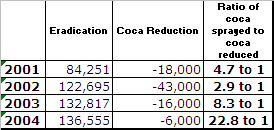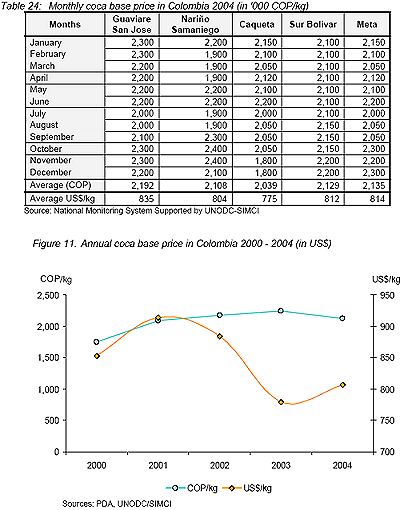« A Visit to San José de Apartadó | Main | Watch your language »
June 16, 2005
The UN's coca data
Once again, the UN Office on Drugs and Crime has given us a fascinating look at current trends in coca cultivation in the Andes. The UNODC Coca Cultivation Surveys for Colombia, Bolivia and Peru released Tuesday are worth a close read.
Here are some of the most striking findings. For the most part, they do not reflect well on Plan Colombia or the current U.S. strategy.
- Neither the UN nor the U.S. government found a significant drop in Colombian coca cultivation in 2004. While the State Department showed Colombian coca holding steady at 114,000 hectares between 2003 and 2004, UN figures indicate a 7 percent drop, from 86,000 to 80,000 hectares.
-
 It is growing ever more difficult and costly to reduce each hectare of coca growing. The UN figures indicate that for every hectare of coca reduced in 2004, 22.8 hectares of coca were sprayed. This is the highest ratio since the UN began finding reductions in Colombian coca cultivation in 2001. (It’s still better than the ratio one would get from U.S. figures, since the State Department found no reduction whatsoever in coca-growing in 2004. You can’t divide by zero.)
It is growing ever more difficult and costly to reduce each hectare of coca growing. The UN figures indicate that for every hectare of coca reduced in 2004, 22.8 hectares of coca were sprayed. This is the highest ratio since the UN began finding reductions in Colombian coca cultivation in 2001. (It’s still better than the ratio one would get from U.S. figures, since the State Department found no reduction whatsoever in coca-growing in 2004. You can’t divide by zero.)
According to former Colombian government drug-policy advisor Alberto Rueda, “Conservative estimates establish that fumigating a hectare costs US$626.” Multiply that by 22.8 and you get the staggering figure of $14,273 spent for every hectare of coca reduced. The UNODC has reported elsewhere (big PowerPoint file) that one hectare of coca gives a farmer a net income of $199 per month. In order to eradicate that hectare, then, the United States in 2004 spent the equivalent of what the farmer would earn from it in six years.
- UN estimates of coca-growing in Colombia continue to diverge widely from U.S. government estimates. The U.S. estimate of Colombian coca in 2004 (114,000 hectares) is 42.5 percent larger than the UN estimate (80,000 hectares). This is a remarkably large margin of error.
While the UN’s measurements show Colombian coca dropping by 51 percent since 2000, the U.S. government’s own figures show a drop of only 16 percent from 2000 levels. (See our comparison of U.S. and UN data for the Andes.)
- According to the UN, the “balloon effect” is alive and well. The UNODC figures found that the small reduction in Colombian coca-growing was more than offset by substantial increases in Bolivia (17 percent) and Peru (14 percent). For the first time since 2000, total Andean coca-growing increased (by 3 percent). This reduction in one country followed by increases elsewhere is another classic example of the “balloon effect” – a phenomenon likening drug-crop eradication to squeezing one part of a balloon, only to see it bulge out elsewhere.
This contradicts U.S. figures, which found no reductions in Colombia but small reductions in Bolivian and Peruvian coca-cultivation. (This led House International Relations Committee Chairman Rep. Henry Hyde [R-Illinois] to report, in a memo to the committee last month, that “We have not seen this balloon effect on coca, as there has not been substantial replanting of coca in Peru, Bolivia, and elsewhere.”) While UN and U.S. estimates diverge widely in Colombia, there isn’t even any agreement on the general trend of coca-growing in Bolivia and Peru.
- Which leads to the point that the satellite imagery used to estimate coca-growing is only able to offer a rough guess. Limitations of satellite methods not only lead to diverging estimates, they appear to allow substantial amounts of coca to go undetected. The UNODC’s reports reveal four such limitations.
 1) In Colombia, the satellite coverage does not cover the entire national territory. As the map indicates, the satellites fail to cover much of several departments of Colombia known to have significant amounts of coca (Arauca, Meta, Vichada, Vaupés and Amazonas). They entirely miss the department of Casanare, which borders several coca-producing departments and is overrun by paramilitaries and guerrillas.
1) In Colombia, the satellite coverage does not cover the entire national territory. As the map indicates, the satellites fail to cover much of several departments of Colombia known to have significant amounts of coca (Arauca, Meta, Vichada, Vaupés and Amazonas). They entirely miss the department of Casanare, which borders several coca-producing departments and is overrun by paramilitaries and guerrillas.
2) The satellites cannot detect small coca plots. The latest Coca Survey recognizes that coca cultivations of less than 0.25 hectares – that’s two-thirds of an acre – are undetectable.
3) The satellites cannot find newly planted or recently harvested coca. The 2003 Coca Survey declared that “Only productive coca plants can be identified by means of multi-spectral image analysis. Unproductive coca, i.e. seedlings, harvested stems or sprayed plants show the same spectral characteristics as bare soil or river banks, and are therefore classified accordingly.”
4) Coca-growers are finding other ways to hide their product. The Bolivia Coca Survey notes that farmers in the Chapare region are growing the bushes among dense weeds, making them “very difficult to detect, even from the ground.” It adds that farmers are increasingly planting coca under the shade of trees, out of the view of satellites and aircraft: “Farmers clear the lower vegetation of forested areas and plant coca seeds or transplant coca seedlings under taller trees. The density of coca plants is not high, but the plants receive enough sunlight to grow.”
- Within Colombia, the “balloon effect” continues. The UN data shows that departments that were a heavy focus of spraying in 2004, like Guaviare, Nariño, Caquetá and Putumayo, registered reductions in coca-growing. However, the reductions were almost completely negated by increases elsewhere. Coca cultivation grew by 46 percent in Meta department, 188 percent in Arauca, 21 percent in Antioquia and 23 percent in the far eastern Orinoco-basin department of Vichada.
Interestingly, Meta (part of the zone where the U.S.-supported “Plan Patriota” military offensive) and Arauca (where U.S. aid is helping Colombian troops guard an oil pipeline) are areas of particular focus for U.S. military assistance programs.
- 62 percent of coca fields detected in Colombia in 2004 were new. This is further evidence that fumigation, in the absence of legal alternatives, is not dissuading farmers from planting coca.
-
 Not only are cocaine prices not rising in the United States – coca base prices are hardly rising in Colombia. One would expect eradication to make the product scarcer, and cause its price to rise. Yet the UNODC reports that the price of coca base – the paste that farmers make from coca leaves – has barely increased in dollar terms, and has stayed about the same in Colombian pesos.
Not only are cocaine prices not rising in the United States – coca base prices are hardly rising in Colombia. One would expect eradication to make the product scarcer, and cause its price to rise. Yet the UNODC reports that the price of coca base – the paste that farmers make from coca leaves – has barely increased in dollar terms, and has stayed about the same in Colombian pesos.
- Unlike the U.S. government, the UN found no decrease in opium poppy cultivation in Colombia last year. The Coca Survey reports, “Based on reconnaissance flights and spray operations conducted in 2004, DIRAN [The Colombian Police Antinarcotics Division] identified approximately 4,000 hectares of opium poppy under cultivation, a similar level compared to 2003.”
This flies in the face of U.S. claims that, in the words of a State Department narcotics official who testified before a House committee last month, “Cultivation of opium poppy in Colombia was reduced by over 65 percent in 2004.”
- In most of the country, UN figures show, spraying is not going hand-in-hand with alternative development. The strategy continues to be all stick and no carrot.

The above table shows coca cultivation, spraying, and alternative-development expenditure in Colombia’s top twelve coca-growing departments over the past several years. It indicates a stark reality: in several of the departments with the most coca and the most spraying, investment in alternative development has been minimal at best.
In Guaviare, the second most-sprayed department in the country, only $500,000 has been dedicated to alternative-development efforts. Nariño, the third most-sprayed department, has seen only $11 million, and most of that has gone to opium poppy-growing zones in the mountains. Caquetá has seen only $5.8 million, while Vichada and Arauca have seen no investment whatsoever – only fumigation.
- The UN reminds us that alternative development – not a further increase in forced eradication – is the key to reducing coca-growing. In Tuesday’s UNODC press release, Executive Director Antonio Maria Costa declares, “This could be a turning point for the Andean region -- farmers are ready to abandon coca cultivation, if legitimate means to earn a livelihood are available. … UNODC data indicates that farmers involved in its alternative livelihood programmes in the Andean region are able to earn more in actual income than counterparts involved in coca cultivation.”
CIP strongly seconds the Coca Survey’s principal recommendation:
There is a window of opportunity for the Andean region—in all three coca-producing countries, the overwhelming majority of farmers indicate their willingness to abandon illicit trade, if assisted in developing alternatives to poverty. The United Nations calls on the international community to focus even more sharply on the ways in which drugs, crime, and terrorism continue to sustain poverty and sabotage the rule of law in the Andean region. We invite greater support for alternative development, the most effective method of creating sustainable growth.
Posted by isacson at June 16, 2005 02:36 PM
Trackback Pings
TrackBack URL for this entry:
http://ciponline.org/cgi-bin/mt-tb.cgi/100
Comments
The sad thing is that the UN, in its current status and structure, can only make suggestions and recommendations, with relatively little if any binding effects.
If alternative development was funded with even 50% of the money that's being spent (both from U.S./EU and Colombia/Other Latin America sources) on fumigation and related eradication tasks, improvements would probably be much more likely.
Of course, actually implementing that money would be far more difficult than simply fumigating some fields and escorting a few planes, but the long terms benefits would potentially outweigh short term troubles.
Instead, apparently the quick spreading of short term "victories" and continous budget "balancing acts"(both in the U.S., the EU and in Colombia, though obviously the specifics are far from being comparable) are just leading us all towards long term indifference or, worse yet, failure.
Posted by: jcg at June 19, 2005 06:42 PM
Post a comment
Thanks for signing in, . Now you can comment. (sign out)
(If you haven't left a comment here before, you may need to be approved by the site owner before your comment will appear. Until then, it won't appear on the entry. Thanks for waiting.)